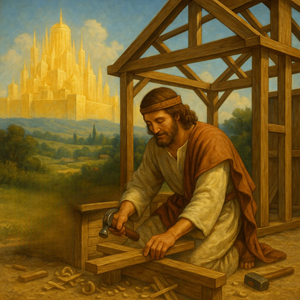
I go to prepare a place for you
The Ancient Hebrew Tradition of the Groom Preparing a Place for His Bride
In Ancient Hebrew culture, the betrothal and wedding customs were rich with symbolic meaning. These traditions not only established a sacred bond between the bride and groom but also provided a profound spiritual parallel to God's relationship with His people, and Christ's relationship with the Church. Central to this tradition was the groom's preparation of a place for his bride in his father's house—a practice that vividly illustrates Jesus' promise in John 14:2-3 :
In my Father's house are many mansions: if it were not so, I would have told you. I go to prepare a place for you. And if I go and prepare a place for you, I will come again, and receive you unto myself; that where I am, there ye may be also.
The Betrothal: Establishing the Covenant
The marriage process began with the betrothal, a formal agreement akin to modern-day engagement but far more binding. During this time, the groom and bride were considered legally married, though they did not yet live together or consummate the marriage. The groom would present a ketubah (marriage contract) to the bride and her family, detailing his promises and responsibilities. This mirrors the covenant God makes with His people:
I will betroth thee unto me for ever; yea, I will betroth thee unto me in righteousness, and in judgment, and in lovingkindness, and in mercies. (Hosea 2:19)
At the Last Supper (Luke 22:20) , Jesus initiated a new covenant with His disciples, symbolizing the betrothal phase of His relationship with the Church.
The Bride Price
The groom also paid a mohar (bride price), demonstrating his commitment and the value he placed on his bride. Similarly, Jesus paid the ultimate price for His bride, the Church, through His sacrificial death on the cross:
For ye are bought with a price: therefore glorify God in your body, and in your spirit, which are God's. (1 Corinthians 6:20)
The Groom's Departure: Preparing the Bridal Chamber
After the betrothal, the groom would return to his father's house to prepare a place for his bride. This place, often referred to as the bridal chamber, was typically an addition to the father's home. The preparation could take up to a year, during which the groom ensured everything was ready for his bride. Importantly, the timing of the completion was determined by the groom's father:
But of that day and hour knoweth no man, no, not the angels of heaven, but my Father only. (Matthew 24:36)
This tradition parallels Jesus' departure to prepare a place for believers. The anticipation and readiness required by the bride reflect the Church's call to watchfulness and faithfulness:
Let your loins be girded about, and your lights burning; And ye yourselves like unto men that wait for their lord, when he will return from the wedding. (Luke 12:35-36)
The Bride's Preparation
While the groom prepared the bridal chamber, the bride remained at her family's home, preparing herself for the wedding. She would focus on her beauty and purity, often wearing fine garments and jewelry. This time symbolized the Church's preparation for Christ's return:
And to her was granted that she should be arrayed in fine linen, clean and white: for the fine linen is the righteousness of saints. (Revelation 19:8)
The Wedding Day: The Groom's Return
When the place was ready, the groom would return for his bride. This event was joyous and often took place at night. The groom's arrival was announced with a shout and the sound of a shofar (ram's horn):
For the Lord himself shall descend from heaven with a shout, with the voice of the archangel, and with the trump of God: and the dead in Christ shall rise first. (1 Thessalonians 4:16)
The bride, who had been keeping watch, would join the groom in the procession to the father's house, where the wedding ceremony and feast took place. This parallels the Church's union with Christ at the marriage supper of the Lamb:
Blessed are they which are called unto the marriage supper of the Lamb. (Revelation 19:9)
The Significance of the Bridal Chamber
The newlywed couple entered the prepared bridal chamber, where their marriage was consummated. This intimate union reflects the eternal fellowship believers will enjoy with Christ. The bridal chamber's preparation was not merely a physical act but a demonstration of the groom's love and dedication, much like Christ's assurance to His followers in John 14:3:
And if I go and prepare a place for you, I will come again, and receive you unto myself; that where I am, there ye may be also.
Conclusion
The Ancient Hebrew tradition of the groom preparing a place for his bride is a powerful illustration of Christ's relationship with His Church. It reminds believers of the sacrificial love of Christ, the importance of readiness and faithfulness, and the glorious hope of eternal union with Him. As the groom's return was anticipated with joy and expectation, so too should the Church eagerly await the return of her Bridegroom, Jesus Christ:
Looking for that blessed hope, and the glorious appearing of the great God and our Saviour Jesus Christ. (Titus 2:13)